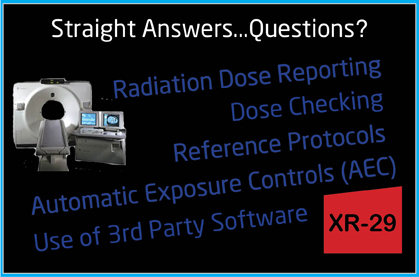Wanted: straight answers.
Creating standards. Improving reporting. Lowering dose to better the health and safety of patients and staff. These are laudable goals, and the new Standard XR-29-2013 from the National Electrical Manufacturers  Association’s (NEMA’s) Medical Imaging & Technology Alliance (MITA) is taking them on.
Association’s (NEMA’s) Medical Imaging & Technology Alliance (MITA) is taking them on.
Otherwise known as MITA Smart Dose, the new XR-29 standard aims to incentivize healthcare organizations to adopt today’s advanced dose optimization and management and dose reduction solutions or be at risk of 5% reductions on CT scans – upwards of 15% or more by 2017 – if they do not meet the technology compliance standards outlined in this policy.
But for many of us who are passionate about this issue and want to support the standard, we are left with more questions than answers.
Many imaging department directors that I have spoken with over the past several weeks have expressed uncertainty and confusion about this standard. The four components are clear – Dose Reporting, Dose Checking, Automatic Exposure Controls (AEC) and Reference Protocols for pediatrics and adults. How to specifically meet these components is what in many areas remains undefined and confusing. Consider the following:
1) Radiation dose reporting: The standard requires “capturing post scan dose information in a standardized electronic format that can be included in the patient’s records.” Is the current functionality of existing CT scanners sufficient? Many CT operators do not know if their scanners are in compliance as this functionality is implemented only in certain CT software versions, which means that the CT operators need to contact the CT vendor to get an answer.
2) Use of 3rd party software: The XR-29 standard states that the 4 required functions shall be attributes of a “CT system (i.e. scanner)”. Should these functions be implemented inside the scanner (by the vendor) or is an add-on 3rd party system that provides these functions acceptable as well (i.e. the “CT System” shall ultimately have this functionality)?
3) Reference protocols: The XR-29 standard requires that reference protocols are pre-loaded to the CT scanner. Who will develop such protocols? Strictly the CT vendor? The healthcare organization? ACR? And what will be their format?
4) Reporting: Who will be responsible to review, audit and report compliance with XR-29 to Medicare/Medicaid? Is it the hospital’s responsibility? Will it fall to ACR in their regular audit of the CT equipment? Others?
I’s a good time for radiology directors to plan to approach their CT vendor and get straight answers about what their current CT system supports. Will it enable you meet all or some of these mandates? Will upgrades truly be necessary? Can your service provide offer a cost effective solution that meets NEMA’s requirements?
And while having these conversations, it’s also an appropriate time to evaluate your low dose options. What is the most cost-effective solution that will lower dose for your patients – and staff - while enabling you to stay within your budget? And can you count on reliable system support when you need it?
I welcome the opportunity to further discuss XR-29 with you and to hear your concerns and your plans to address this mandate. While I can’t promise to resolve all your questions related to XR-29 and your CT vendor, I can promise straight answers and responsiveness as it relates to Medic Vision.
For more information contact Jeff Weiss at 212-366-9100 or jeffweiss@atlantisworldwide.com
Some blogs you may have missed:
- CT Radiation Dose Reduction Project
- Q & A: How One Practice Achieved Extreme Low Dose
- Mobile CT brings low-dose lung cancer screening to underserved



